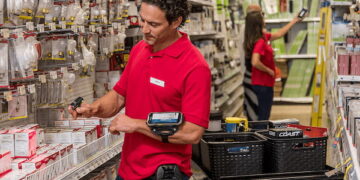Crédito: fuente
A critical test-firing of NASA’s Space Launch System moon rocket in Mississippi ended just 67 seconds after it began Saturday, well short of a planned eight-minute burn that was supposed to clear the way for the space agency to finally ship the rocket’s core stage to the Kennedy Space Center in Florida for launch preparations.
The SLS core stage, built by Boeing, lit its four Aerojet Rocketdyne RS-25 engines for the first time at 5:27 p.m. EST (4:27 p.m. CST; 2227 GMT) Saturday for a burn that was expected to last more than eight minutes, the culmination of a year-long series of checkouts at the Stennis Space Center in southern Mississippi.
Fastened to the mammoth B-2 test stand at Stennis, the 212-foot-tall (98-meter) SLS core stage throttled up to full power after the four main engines lit at 120-millisecond intervals.
The engines, leftovers from the space shuttle program, built up to 1.6 million pounds of thrust, making Saturday’s hot fire test the most powerful rocket firing at the Stennis Space Center since NASA tested the Apollo-era Saturn 5 moon rocket on the same stand in the 1960s.
But after rumbling to life and generating a ground-shaking thunder for a little more than a minute, the RS-25 engines cut off on command of the rocket’s on-board computer system, which detected an unspecified fault in one of the powerplants.
Engineers were tracing the cause of the premature engine shutdown Saturday night, but NASA officials had few details on what might have triggered the early end to the test-firing.
“I know not everybody is feeling as happy as we otherwise could because we wanted to get eight minutes of a hot fire, and we got over a minute,” said NASA Administrator Jim Bridenstine.
Before the test-firing Saturday, NASA officials said preparations were on track for the first test flight of the Space Launch System at the end of 2021. It was not immediately how the premature shutdown of the SLS engines Saturday might impact that schedule, although it will certainly add more risk to it.
“We got lots of data that we’re going to go through, and be able to sort through, and get to a point where we can make a determination as to whether or not launching in 2021 is a possibility or not,” Bridenstine said. “While today was not everything we hoped it would be, this was an important day.”
The outgoing NASA chief, who will leave his post Wednesday with the end of the Trump administration, said engineers gathered important data on the performance of the rocket despite the cutoff of the engines. The Space Launch System is a major piece of NASA’s Artemis program, which aims to return astronauts to the moon for the first time since 1972.
The SLS will launch NASA’s Orion crew capsule to send astronauts to the vicinity of the moon, NASA plans to construct a mini-space station to serve as a research outpost and waypoint for crews traveling between Earth and the lunar surface. The Orion spacecraft will link up with a descent craft in lunar orbit, where astronauts will float into the lander to head for the moon’s surface.
Here’s a replay of the first hotfire test of the Space Launch System core stage, which was cut short a little more than a minute into a planned eight-minute firing.
The rocket and engines safely shut down. NASA plans a post-test media briefing tonight.https://t.co/B639YAgQec pic.twitter.com/FXHuxAV7ok
— Spaceflight Now (@SpaceflightNow) January 16, 2021
The first SLS test flight, known as Artemis 1, will launch an Orion spacecraft to orbit the moon without astronauts. A second SLS/Orion flight around the moon in the 2023 timeframe will have three astronauts and a Canadian crew member.
The Trump administration’s goal of a human landing at the moon’s south pole by the end of 2024 is rapidly fading. The timeline was aggressive from the moment Vice President Mike Pence announced the 2024 moon landing objective in 2019. But Congress has not appropriated the funds NASA said it needed to develop human-rated lunar landers to meet the schedule, raising further doubts about the 2024 deadline.
Space policy experts believe the Biden administration is unlikely to keep the 2024 schedule goal for a lunar landing, but may pursue a slower effort to get U.S. astronauts back to the moon.
The Space Launch System has been repeatedly delayed since the program’s announcement in 2011, missing targets for its debut in 2017, 2018, 2019, and 2020. NASA spent more than $18 billion on the SLS program from 2011 through Sept. 30, 2020.
“This is a program that is important to the United States of America, it’s important for our leadership in the world, it’s important for us to go to the moon, and to go quickly,” Bridenstine said Saturday, adding that the purpose for the Artemis program goes beyond science.
“It’s about a tool of diplomacy. It’s about American leadership. It’s about exploration,” he said.
Getting all four RS-25 engines to fire simultaneously was “a win in itself,” Bridenstine said. The engines flew three-at-a-time on the space shuttle.
During development of the Saturn 5 moon rocket and the space shuttle, NASA fired test articles at Stennis to verify the propulsion system design. In order to save money, the first full-up SLS core stage serves as both a test article and a flight unit. NASA officials said they are being extra careful with the stage because it is eventually intended to fly.
“This is not a failure,” Bridenstine said. “This is a test… We’re going to make adjustments, and we’re going to fly to the moon.”
Based on an analysis of the video and audio aired on NASA TV, the first sign of trouble during the abbreviated SLS hot fire test came about 50 seconds after engine ignition, when an engineer on the test team declared an “MCF” or a “Major Component Failure” on Engine No. 4.
“Copy that, but we’re still running, we’ve still got four good engines, right?” the test conductor replied on a communications net.
“Yeah, copy that,” a member of the test team said.
Shortly after the MCF call, about 67 seconds after engine start, video showed the core stage engines appearing to be in a shutdown sequence. A verbal confirmation of the engine shutdown came a few seconds later from a member of the test team.
“There was some conversation around an “FID” on Engine 4, which is our terminology for a Failure Identification, shortly followed by an MCF, which is a Major Component Failure,” said John Honeycutt, NASA’s SLS program manager, in a press conference a few hours after the test. “I don’t know much more about that than you do at this point in time. Any parameter that went awry on the engine could send that Failure ID.”

The engines shut down around a minute into the test program, around the same time the RS-25s were programmed to throttle back to 95% thrust before powering back up to full power at 109% of rated performance. At the same time, the engines were supposed to be swiveled using hydraulic gimbals.
“So there’s a lot of dynamics going on at that point in time,” Honeycutt said. “We did see a little bit of a flash coming from around the interface of the thermal protection blanket on Engine 4 at the time we initiated the gimbal, (or) thereabouts.
“At that point in time … the engine controller sent the data to the core stage controller to shut the vehicle down,” Honeycutt said. “The team accomplished a lot today, we learned a lot about the vehicle, we got the vehicle loaded, we got our pressurization system wrung out, we got the engines conditioned, and got roughly 60 seconds of time on the RS-25s.”
John Shannon, Boeing’s SLS program manager, said before the test-firing teams wanted to get at least 250 seconds of run time on the core stage before moving on from the hot fire. By that point in the test, the engines would have throttled down and powered back up to full thrust and completed two gimbal profiles, including a sweep at about T+plus 2 minutes, 30 seconds, to check the structural response to the engine movements.
“We have said all along that we would like to get to at least 250 seconds, but I think we need to do our due diligence and go look at the data we collected to ensure that we’ve got a good plan moving forward,” Honeycutt said.
Bridenstine said Saturday it was too soon to know for sure whether engineers will need to perform another core stage hot fire test, or whether the early engine shutdown is likely to delay the first SLS test launch, known as Artemis 1 the mission, into 2022.
“It depends what the anomaly was, and how challenging it’s going to be to fix it,” Bridenstine said. “And we’ve got a lot to learn to figure that out. So I think it very well could be that it’s something that’s easily fixable, and we could feel confident going down to the Cape and and then staying on schedule. It’s also true that we could find a challenge that’s going to take more time.”
NASA could have shipped the SLS core stage to the Kennedy Space Center before the end of February if Saturday’s test-firing went perfectly, and moved the stage into place for stacking with two solid rocket boosters, an upper stage, and the Orion spacecraft. Assuming NASA officials decide to redo the hot fire test, February is the the earliest another test-firing might happen.
It takes three to four weeks to dry out the RS-25 engines, perform inspections, and ready the core stage for a second hot fire test, assuming managers decide to go for another test-firing, Honeycutt said. That turnaround time does not factor in how long it might take to complete any repairs to fix the problem that caused the premature end to Saturday’s hot fire test.
Each of the four RS-25 engines that fired Saturday flew on NASA’s space shuttle fleet. The engines launched on 21 shuttle missions as far back as 1998.
NASA has spare RS-25s available if engineers need to replace one of the engines on the first SLS core stage. Ground crews at Stennis could swap engines with the rocket mounted on the test stand, officials said.
“We’ve got to fully understand the problem, and do an assessment of the core stage as well as the engines to make sure we understand the problem and what needs to be fixed or repaired, if we need to,” Honeycutt said Saturday night.
The only damage to the rocket observed after Saturday’s test-firing was on the thermal blanket near Engine No. 4, where teams noticed the flash just before engine shutdown, Honeycutt said.
Asked if any of the data analyzed so far suggest engineers need to make any major changes to the core stage, Honeycutt said: “What I’ve seen so far about the performance of the hardware during the wet dress rehearsals that we’ve had, during the hot fire today, and the limited amount of imagery I’ve been able to see so far, I don’t think we’re looking at a significant design change.”
Email the author.
Follow Stephen Clark on Twitter: @StephenClark1.








